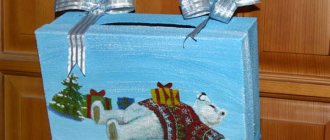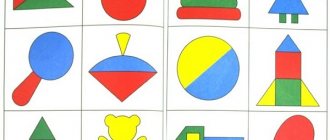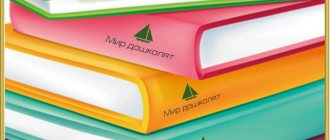Typical speech disorders in children 5-6 years old
Most older preschoolers have difficulties with:
- mastering sonorous and hissing sounds;
- sound analysis of words;
- development of narrative speech;
- writing a story and descriptions.
Of course, such problems can be minor, only slightly different from the age norm, or serious, up to and including general speech underdevelopment (GSD). It is necessary to contact a speech therapist in any case, but the supportive work of parents at home is also very important.
It is worth noting that regular speech therapy exercises and classes for children 5-6 years old are useful for every child at home, because they help to master literacy faster.
Rules for speech therapy classes at home
The success of home lessons depends not only on the availability of the necessary aids and a work plan agreed upon with the speech therapist. The organization of classes itself is very important. Here are a few simple rules that will help you achieve excellent results:
- All speech therapy exercises for children should be carried out regularly, but a little at a time. You shouldn’t try to do articulation gymnastics, play speech games, or fill out a workbook right away. It is better to devote a few minutes to each type of exercise, rather than having a whole “speech therapy day.”
- Do not force them to complete tasks under pressure; educational activities for children should resemble a game. Come up with a simple plot (for example, a journey into the universe of sounds), prepare small prizes (stickers, paper stars), and arrange physical exercises.
- Praise and support the little student if he makes even the slightest progress. Focus on achievements, even small ones, gradually progress will become more and more obvious.
- Find good workbooks for home practice. They should not only be professional in content, but also bright, colorful, and exciting. It is ideal if the tasks have interactive elements (the opportunity to add something, draw something). Such material makes it possible to interest a preschooler and clearly shows him the “path traveled” and success.
- Don't expect instant results, be patient and gentle perseverance. The process of setting, consolidating, and differentiating sounds is complex; it takes months even for experienced speech therapists. Follow the plan and the results will gradually appear.
Speech therapy exercises for practicing at home
All speech therapy exercises can be divided into three large blocks, each of which needs to be given attention and carried out regularly:
Development of phonemic hearing
The ability to distinguish sounds by ear seems natural, but if you ask your preschooler to spell a word, you will see gaps.
For children 5-6 years old, there are a large number of special games and exercises that help develop phonemic hearing. These include:
- selection of words starting or ending with a given sound;
- counting sounds in a word, determining the syllable structure;
- drawing up a sound diagram of a word;
- inventing rhymes and short poems;
- pronouncing speeches and tongue twisters.
Thoughtful speech therapy classes for children 5-6 years old make it possible to make all the sounds of their native language obedient and easy.
Finger gymnastics
Fine motor skills of the hands help speech activity, so older preschoolers must do it without fail.
Of course, for children 5-6 years old, the exercises should be complex, with a script, in verse. It is useful to select sets of exercises for both hands at the same time, synchronous. Don't forget to use "helpers":
- small massagers (rubber balls, rollers, cones);
- scissors for cutting;
- plasticine;
- origami paper.
Also remember that all types of needlework, construction, and any creativity are great ways to improve fine motor skills outside of individual lessons.
Articulation gymnastics
Special language exercises must be performed every day if there are any problems with pronunciation. For home exercises, it is best to choose a set of exercises with a poetic description and pictures.
Do a tongue warm-up every day, always in front of a mirror (this allows the baby to observe the process himself, assessing its success). If you have problems with one or two sounds, then articulatory gymnastics should be selected for them. These can be found in thematic workbooks on speech therapy.
Methodological materials for speech therapist teachers
Contained in sections:
- Methodological materials for teachers and educators 28713
- Speech development. Speech development of children 15982
Includes sections:
- Articulation. Articulation gymnastics 1611
- Bilingualism, bilingualism 216
- Bioenergoplastics in working with children 129
- Dysarthria 256
- Dysgraphia and dyslexia. Prevention and correction 272
- Kinesiology. Kinesiological exercises and games for children 480
- Speech therapist consultations for parents 1636
- Corrective work. For teachers of correctional groups 322
- Corrective classes. Notes for correctional groups 4209
- Speech therapy classes 9681
- Speech therapy and speech holidays and entertainment. Scripts 1966
- Speech therapy games 1461
- Speech therapy rooms. Educational environment 208
- Logorhythmics. Logorhythmic exercises 1497
- Fine motor skills 11913
By groups:
- Senior group
- Preparatory group
- Middle group
- Junior group
Showing publications 1-10 of 8564. All sections | The work of a speech therapist. Speech therapy
New
Photo
The best
Lego construction in speech therapy practice In modern conditions, the task of a speech therapist is to combine all areas of correction in his work . It is considered important to involve different analyzers - auditory, visual, tactile - in compensating for speech disorders. The greater the number of sense organs involved in the correction...
Master class “The use of fiction in the correctional work of a speech therapist” Master class “The use of fiction in the correctional work of a speech therapist ” Goal: to improve professional skills in the field of speech development of preschool children. Objectives: 1. To increase the level of competence of teachers in matters of speech development...
Speech therapy tasks
Starting with the letter R
One of the most difficult sounds to master is R. Many preschoolers learn to roar loudly by the very end of kindergarten. If the production of the sound P is already behind you, then special exercises will help speed up its automation:
1. “Like a little motor”
We ask the child to pronounce the sound R in the word for a long time, drawlingly (like a motor growls).
2. “Where is R hiding?” (in pictures and words)
Offer to choose pictures with images of objects with a given sound or clap your hands if he hears such a word.
3. “How can you growl?”
Show your child pictures of objects that have the sound r in their names. Offer to read and color the picture.
4. “Sounding tracks”
Together with your child, come up with several chants made up of several syllables:
Ra-ra-ra - they ran away from the yard.
Ro-ro-ro - and they found a bucket.
Ru-ru-ru - we came up with a game.
5. “Substitute a syllable”
The adult offers the child words that end or begin with a syllable with P (ra, ro, ry), the child must choose the correct option and pronounce it correctly.
6. “Look and name”
An adult asks the child to read words with the letter r from the pictures. The word must be said as many times as there are stars next to each picture.
7. “Poems, tongue twisters, riddles”
Learn with your child several poems and riddles in which words with R appear.
The necessary tasks for speech development can be found in the Workbook for the sound R, compiled by Kostyuk A.V.
Download, print the tasks in pictures and study at home:
Speech therapy tasks for the letter P
Starting with the letter L
The hard sound L is also often difficult for children 5-6 years old. If the baby has already learned to pronounce it alone, in isolation, then it’s time to start working on automation in speech. The following exercises are suitable for this:
1. “Say it nicely”
Offer your child several images of words starting with L. Ask him to pronounce the words beautifully, emphasizing the desired sound with his voice.
2. “Toys for Larisa”
Ask your child to collect gifts for the Larisa doll. Tell her that she only likes things that begin with L. For this exercise, you need to select small objects or pictures in advance; all words should not begin only with L.
3. “One-many”
Invite your child to name words with L in the singular and plural. In the workbook for the sound L (author Kostyuk A.V.) there is a whole table with pictures for this exercise (lesson 20).
4. “Find the Sound”
Invite your child to draw up a diagram of the word and mark the place L on it. If it is still difficult for your child to independently determine the number of sounds, then first you can do several similar exercises from the workbook.
5. “Tongue twisters and nursery rhymes”
Use nursery rhymes, tongue twisters and poems with words that contain L.
Download and print tasks in pictures starting with the letter L:
Speech therapy tasks for the letter L
Speech therapy manual “Speech”
The purpose of this manual: Using visual aids, increase the effectiveness of speech therapy, generate interest in classes, and create positive motivation in children with speech disorders.
Tasks:
— expansion and enrichment of vocabulary on lexical topics;
— development and improvement of the grammatical structure of speech;
— automation of sounds in speech;
— development of visual gnosis;
— learn to establish logical connections between objects;
— development of phonemic hearing, analysis, synthesis;
— development of coherent speech skills;
- development of spatial concepts, mathematical concepts, perception of color, shape, size;
— development of mental processes (attention, perception, memory, logical thinking);
- development of fine motor skills.
The main job of a teacher-speech therapist is to develop all aspects of speech in children. Often speech therapists are in dire need of didactic and gaming aids, since repeated repetitions of the same material tire not only the child, but also the adult. And then the speech therapist has to figure out how and how to diversify the classes so that the material being worked on does not bore the child and is interesting for him. After all, only positive motivation will contribute to effective work, which will subsequently lead to the desired result.
It is this fact that leads to the search for new methods of work, new universal aids that make it possible to work on the formation of all aspects of a child’s speech.
The “Rechevichok” manual corresponds to a system-active approach, is accessible and safe. The Velcro album helps to work on the development of all aspects of speech, from consolidating correct sound pronunciation to working on the formation of coherent speech. The exercises offered to children help not only eliminate speech disorders, but also contribute to the formation of attention and memory, increase efficiency, activate mental operations, and prepare children for school.
The work uses visual aids in the form of bright and interesting laminated pictures - bases with silhouettes and contour drawings, and pictures on Velcro, stickers and toys, which allow a beneficial effect on the emotional state of children, maintain interest in classes, and form voluntary attention when working with the proposed material.
This manual is intended for different age categories (from 3 years to 7 years). The manual can be used both in individual work with a child and in working with two children at the same time, since it has two and three working surfaces. It is also possible to perform exercises as a team.
“Speech” can be used by educators in classes on speech development and literacy. This fact is very important, because the teacher-speech therapist has the opportunity to recommend consolidation of certain speech skills and help in the selection of visual material (interaction with kindergarten teachers and specialists).
The relevance of this manual lies in the fact that when working with children with speech impairments, it can be very difficult to interest and retain their attention, to awaken interest in the content of the lesson and the learning process as a whole. The use of this game aid facilitates the learning of educational material by children and increases the effectiveness of speech therapy work. The versatility of the manual is expressed in the variety of didactic material that can be used in accordance with the intended purpose. The manual is multifunctional, its use depends on the tasks of the speech therapist in a particular lesson. Pictures from one game can be peeled off and used in other games.
Thanks to the use of Velcro games, the learning process takes place in an accessible and attractive environment for preschool children. The manual can be supplemented as necessary with other games and details. It is convenient to put away parts that were not needed for a particular lesson in the pockets located in the folder. Working with this manual allows you to systematize all the visual material available to the teacher-speech therapist and use it productively in the classroom.
Below are examples of using the “Speech” manual.
Game “Glue the flowers and butterflies yourself”
Goal: learning and consolidation of color, development of thinking, development of visual concentration.
The child needs to find a picture by color and glue it to a house or flower.
You can immediately offer the child games - tasks: “One - many”, “Which picture is the odd one out?”, “Who-what?”, “Make a sentence.”
Game “What fruits and berries do you know?”








